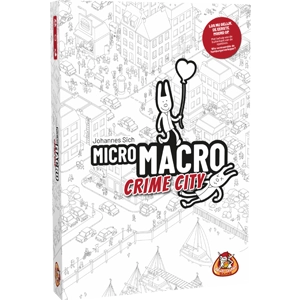Micro Macro Crime City
Welcome to Crime City, a quiet town overrun by crime. We need your help to stop crime in the city. You work together as a team to solve the numerous crimes in the city.
Game equipment
1 City map
1 Magnifying glass
120 Examination cards
16 Envelopes
For the first game
- Stick the attached sticker on the magnifying glass
- There were 16 different crimes committed in the city. Each crime consists of a number of cards. On each card you will find a symbol and the number of the card in the upper right corner. Put all the crimes in the enclosed envelopes before starting the first game.
Try not to look at the text on the various cards!
Preparation
Place the city card face up in a spot accessible to all players. It is best to place the map on a large table, but you can also hang the city map on the wall or you can play on the floor.
- Make sure all players can see the city map clearly. Make sure everyone can walk around the map and see the map from all angles.
- Make sure you have good light. Daylight or good artificial light is very important. This game often revolves around noticing small details that are harder to see in poor light.
- The city map should always be fully visible. Do not place other things on the city map and keep the research cards next to the city map. By placing something on the city map, you can miss important details of a crime.
- Important: You need sufficient light. If it seems that the details on the map are too small or the characters are too similar, this can often be solved by more or better light.
Here we go!
To get acquainted with MicroMacro, we recommend starting with the introductory game: The top hat. You can begin solving the crime while reading the rest of the game rules.
- Appoint 1 player as principal investigator. The principal investigator leads the study and reads all the study cards aloud.
- Take all the cards from The High Hat out of the envelope. Place the cards in a draw pile next to the city card.
- The top card of a crime is always the starting card of the investigation. On the starting card you will find an overview of the crime and a picture of the main character. The principal investigator turns over the starting card and reads the text on the card aloud.
Read the texts loudly and clearly to all players. Also, always show the pictures to all players. On the cards and in the text you will find important information.
- On the front of the second card is your first assignment. All assignments have a black background. The principal investigator reads this card without turning the card over.
- The solution to the task is always a specific spot on the city map. Start looking for the place being sought. When you think you have found the correct solution, the chief investigator turns over the map and checks that the coordinates of the spot match your answer.
The intention is not to gamble. Get serious and be sure about your solution to the assignment.
- If the answer is correct, the principal investigator reads the text on the back of the card and shows the picture on the back of the card to all players.
- If the answer is wrong, the principal investigator puts the card back on the pile without reading the text on the back of the card. The principal investigator indicates that the answer is wrong and that further searching on the city map is required. The principal investigator now knows the answer and may no longer join the search. When the team is on the wrong track, the lead investigator may give a little hint.
- Once you solve a card’s assignment, discard the card. The next card from the draw pile has a subsequent mission.
- Now solve the four tasks of the introduction game one by one.
- You now know how to play the game and are ready for all the other crimes!
Use the magnifying glass if you want to take a closer look at certain parts of the city map.
Now try to play the first five scenarios in succession. The number of stars on the crime map indicates the difficulty of the crime.
Tips
- You can mark spaces with coins or playing pieces from other board games to get a better overview of the crime.
- As with most cooperative games, there is a chance that a few players will take charge and dominate the game. Make sure everyone has the same opportunity to participate in solving the crimes.
Micromacro for advanced students
If you have already solved some issues quickly, we recommend the advanced variant. You take crime investigation cards and read only the starting card. Now try to solve the case WITHOUT using the other investigation cards. Often the text on the cards contains hints. Not looking at the cards increases the difficulty of the game. Once you have seen everything about the crime, you can solve the whole crime in 1 go. If you are unsure about a part or get stuck, you can look at the cards up to the point of being stuck. Perhaps this will give you a hint or discover an error in your theory of the crime.
All issues resolved?
Hidden in the city map are additional secret puzzles to keep you busy for a while longer. Do you also know how to solve these issues:
- Why is a man pushed into the water by the river?
- A baby is missing. What happened to the baby?
- At the pub down south, a man reports to police that his bag has been stolen. Where is his bag?
The answers to these questions and other hidden puzzles can be found at micromacro-game.com.
Game design: Johannes Sich
Development: Hard Boiled Games, Johannes Sich, Daniel Goll, Tobias Jochinke
Graphic design: Marco Terpstra
Graphic design: Philip Behrend, Verso Endemann, Marcel Malchin
Dutch translation: Emmy Steenackers
Project manager: Jonny de Vries
Final editing: Elise Gielen

